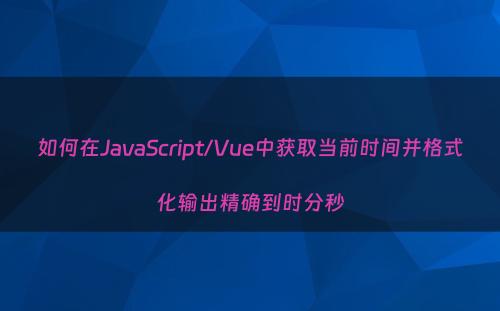网站首页 > 基础教程 正文
Vue 示例
在JavaScript或Vue中获取当前时间并格式化输出到精确的时分秒,你可以使用Date对象结合字符串拼接或者模板字符串来实现。下面是一个简单示例,展示了如何在Vue中完成这项任务:
<template>
<div>
<p>当前时间:{{ formattedTime }}</p>
</div>
</template>
<script>
export default {
data() {
return {
formattedTime: ''
};
},
mounted() {
this.updateTime();
setInterval(this.updateTime, 1000); // 每秒更新一次
},
methods: {
updateTime() {
const now = new Date();
// 使用模板字符串进行格式化
this.formattedTime = `${now.getFullYear()}-${this.padZero(now.getMonth() + 1)}-${this.padZero(now.getDate())} ${this.padZero(now.getHours())}:${this.padZero(now.getMinutes())}:${this.padZero(now.getSeconds())}`;
},
// 辅助函数,用于补零操作
padZero(num) {
return num < 10 ? '0' + num : num;
}
},
beforeDestroy() {
// 清除定时器,避免内存泄漏
clearInterval(this.timer);
}
};
</script>在这个示例中,我们在Vue组件的mounted生命周期钩子中初始化了一个定时器,每秒钟调用updateTime方法来更新当前时间,并在组件销毁前通过beforeDestroy钩子清理定时器。

updateTime方法中,我们创建了一个新的Date对象来获取当前时间,然后使用模板字符串和辅助函数padZero来确保月份、日期、小时、分钟和秒数如果是个位数,则在其前补零,以便格式统一和美观。
这样,页面上就会显示一个实时更新的当前时间,格式为“年-月-日 时:分:秒”。
Vue3 Composition API 示例
在Vue3中,虽然一些API和写法有所变化,但获取和格式化当前时间的基本逻辑与Vue2相似。以下是使用Vue3 Composition API的一个示例:
<template>
<div>
<p>当前时间:{{ formattedTime }}</p>
</div>
</template>
<script setup>
import { ref, onMounted, onBeforeUnmount } from 'vue';
const formattedTime = ref('');
let timer = null;
const updateTime = () => {
const now = new Date();
formattedTime.value = `${now.getFullYear()}-${padZero(now.getMonth() + 1)}-${padZero(now.getDate())} ${padZero(now.getHours())}:${padZero(now.getMinutes())}:${padZero(now.getSeconds())}`;
};
const padZero = (num) => {
return num < 10 ? '0' + num : num;
};
onMounted(() => {
updateTime();
timer = setInterval(updateTime, 1000); // 每秒更新一次
});
onBeforeUnmount(() => {
// 清除定时器
clearInterval(timer);
});
</script>在这个Vue3的示例中,我们使用了Composition API来管理状态和生命周期钩子。ref用于定义响应式数据formattedTime,而onMounted和onBeforeUnmount分别替代了Vue2中的mounted和beforeDestroy生命周期钩子。
updateTime函数和padZero辅助函数的功能与Vue2示例相同,用于获取当前时间并进行格式化处理,以及在数字小于10时前面添加零。
这样,你就可以在Vue3应用中实现实时更新并格式化显示当前时间的功能。
TypeScript 公共函数封装
使用TypeScript可以为你的代码增加类型安全。下面是如何封装一个获取并格式化当前时间的公共函数,这个函数可以在Vue3的项目中作为公共方法使用。
首先,在你的Vue3项目的某个公用文件夹(如src/utils)下创建一个名为dateTimeUtils.ts的文件,并编写如下代码:
// src/utils/dateTimeUtils.ts
export function formatCurrentTime(): string {
const now = new Date();
return `${now.getFullYear()}-${padZero(now.getMonth() + 1)}-${padZero(now.getDate())} ${padZero(now.getHours())}:${padZero(now.getMinutes())}:${padZero(now.getSeconds())}`;
}
function padZero(num: number): string {
return num < 10 ? '0' + num : num.toString();
}
这个模块导出了一个formatCurrentTime函数,它返回当前时间的格式化字符串。同时,内部使用了padZero辅助函数来保证数字的格式正确。
然后,在你的Vue3组件中,你可以这样使用这个公共函数:
// 某个Vue3组件.vue文件
<script setup lang="ts">
import { onMounted, ref } from 'vue';
import { formatCurrentTime } from '@/utils/dateTimeUtils'; // 根据你的实际路径调整
const formattedTime = ref('');
onMounted(() => {
formattedTime.value = formatCurrentTime();
setInterval(() => {
formattedTime.value = formatCurrentTime();
}, 1000);
});
</script>
<template>
<div>
<p>当前时间:{{ formattedTime }}</p>
</div>
</template>这里,我们导入了formatCurrentTime函数,并在组件挂载时设置初始值,之后每秒更新一次显示的时间。注意,为了避免潜在的内存泄漏,如果组件需要销毁时停止时间更新,你可能还需要在适当的生命周期钩子中清除定时器,正如之前Vue2和Vue3 Composition API示例中所示。不过,在此示例中为了保持简洁,省略了该部分代码。
- 上一篇: JavaScript学习笔记(十四)
- 下一篇: 十年前的js代码
猜你喜欢
- 2024-11-19 JavaScript 根据指定的字符串格式格式化日期
- 2024-11-19 前端时间格式化下,让用户看时间一看就懂的方法
- 2024-11-19 WPS表格如何在宏代码中判断日期类型及获取年、月、日
- 2024-11-19 快来领取,33个常用JavaScript功能已封装成方法,拿来即用
- 2024-11-19 JavaScript中的日期对象
- 2024-11-19 十年前的js代码
- 2024-11-19 JavaScript学习笔记(十四)
- 2024-11-19 Node.js 实现抢票小工具&短信通知提醒(下)「干货」
- 2024-11-19 JS短文:如何确定一个月中有多少天?
- 2024-11-19 如何在Vue.js中对时间格式化
- 最近发表
- 标签列表
-
- jsp (69)
- gitpush (78)
- gitreset (66)
- python字典 (67)
- dockercp (63)
- gitclone命令 (63)
- dockersave (62)
- linux命令大全 (65)
- pythonif (86)
- location.href (69)
- dockerexec (65)
- tail-f (79)
- queryselectorall (63)
- location.search (79)
- bootstrap教程 (74)
- deletesql (62)
- linuxgzip (68)
- 字符串连接 (73)
- html标签 (69)
- c++初始化列表 (64)
- mysqlinnodbmyisam区别 (63)
- arraylistadd (66)
- mysqldatesub函数 (63)
- window10java环境变量设置 (66)
- c++虚函数和纯虚函数的区别 (66)
